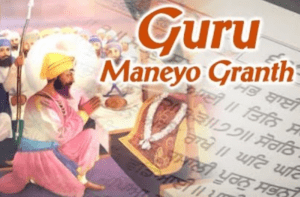 Guru Maneyo Granth—Guru Gobind Singh
Guru Maneyo Granth—Guru Gobind Singh
Guru Maneyo Granths-Those who wish to take us back to the worship of gods and goddesses.
The Reality behind the misleadingly named Dasam Granth
The so-called Dasam Granth is a compilation of largely amoral myths and stories produced by Brahmins to fool gullible Sikhs into diluting and distorting the teachings of the Gurus with Hindu mythology.
Evidence
- Guru Gobind Singh gave Gurgadhi to the Guru Granth Sahib alone.
- Neither Guru Gobind Singh nor his contemporaries ever referred to any such composition.
- The first reference to such a composition was made not by a Sikh but revealingly, by a Brahmin called Chibber, 70 years after Guru Gobind Singh.
- Chibber himself admits that what he wrote was based on hearsay.
- The first mention of ‘Dasam Granth’ was much later, in 1850 at a time of Hindu resurgence in Punjab.
- The mischievously named Dasam Granth contains tales of the amorous exploits of Hindu gods and goddesses.The whole notion of gods and goddesses is contrary to Sikh teachings on one God of all humanity (Ek Onkar), who is beyond birth, death and human frailty.
- The Mool Mantar states that God does not take birth. The Dasam Granth says God took birth 24 times.
- Sikh teachings emphasise the dignity and complete equality of women. The Dasam Granth denigrates women as lesser beings who are always ready to entice men to their will with their supposed 404 wiles. Women it claims, are ready to resort to intrigues and commit murder to get their way. It says that even God regretted creating such beautiful creatures.
- In a translation of ‘The Poetry of the Dasam Granth’ former Vice President of India Dr S Radhakrishanan and Dr Dharam Pal, state: ‘in most of the tales, the themes are love, sex debauchery, violence, crime or poison. They are extremely racy and frankly licentious’.
- Out of respect for common decency, this note does not give examples of these pornographic writings.
- The so-called Dasam Granth was first propagated by Hindu Arya Samaj extremists, who included in it some compositions, which could possibly be those of Guru Gobind Singh, to make it more appealing to Sikhs. NOTE: These were examined by eminent Sikh scholars in several years of extensive consultation and are listed in the 1945 Rehat Maryada published by the SGPC, as being in consonance with Sikh teachings. The rest of the Dasam Granth was unanimously rejected.
- In the years following the 1984 holocaust, Hindu extremists have tried to finish Sikhism in the Punjab, and to this end, the Punjab Government produced and distributed thousands of copies of the Dasam Granth, free of cost to many towns and villages in Punjab.
- One can understand uneducated villagers in Punjab being misled by the word ‘dasam’ sadly, some educated Sikhs in the UK are also being misled to reject the clear and far-sighted message of Guru Gobind Singh sung after the Ardas-Guru Maneyo Granth, consider the teachings of the Guru Granth Sahib to be the sole perpetual guidance for all Sikhs.
[Ends]



 A Report commissioned by the Foreign Secretary Jeremy Hunt has found that the persecution of Christians in many parts of the world amounts to what some see as near genocide. Millions of Christians have been uprooted from their homes, and many have been killed, kidnapped, imprisoned and discriminated against.
A Report commissioned by the Foreign Secretary Jeremy Hunt has found that the persecution of Christians in many parts of the world amounts to what some see as near genocide. Millions of Christians have been uprooted from their homes, and many have been killed, kidnapped, imprisoned and discriminated against.